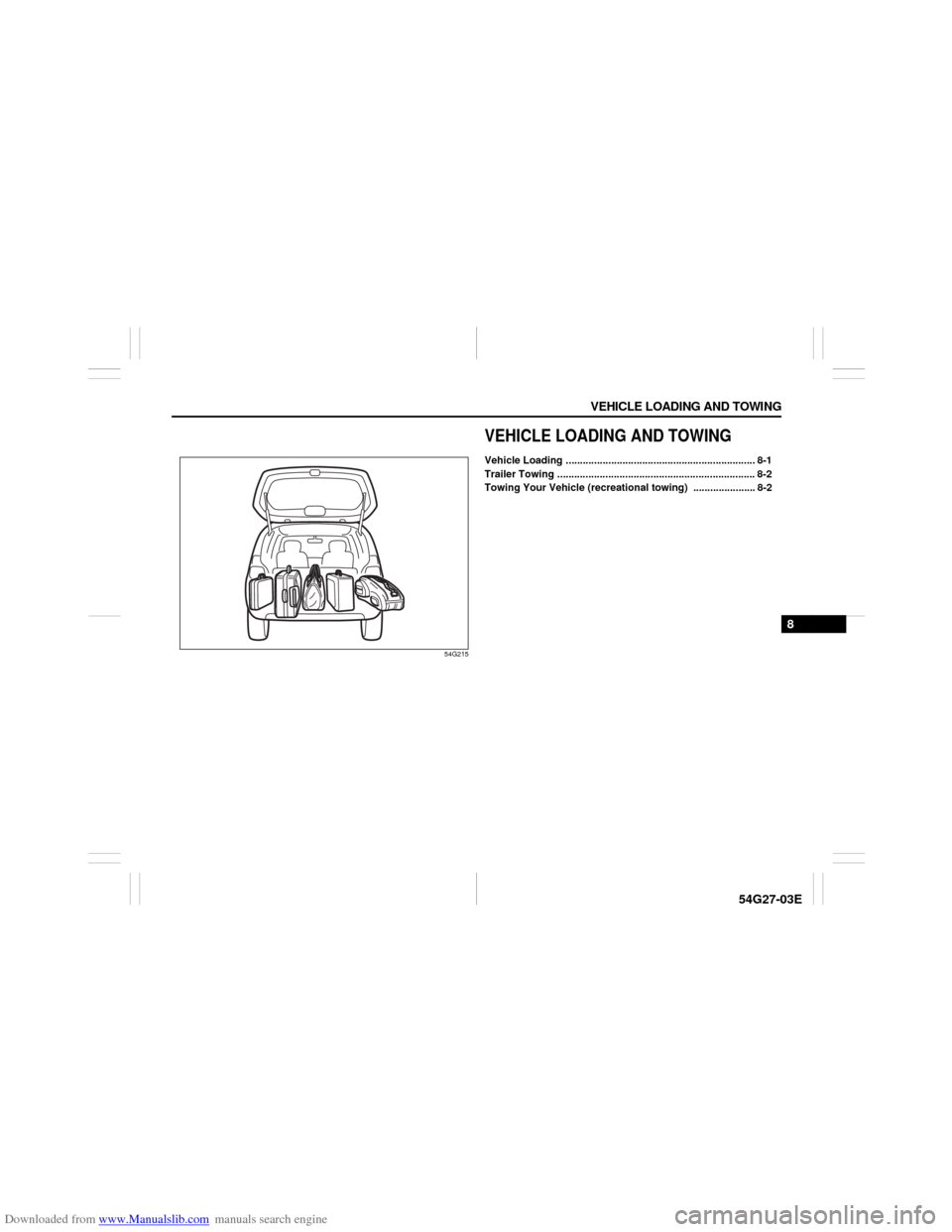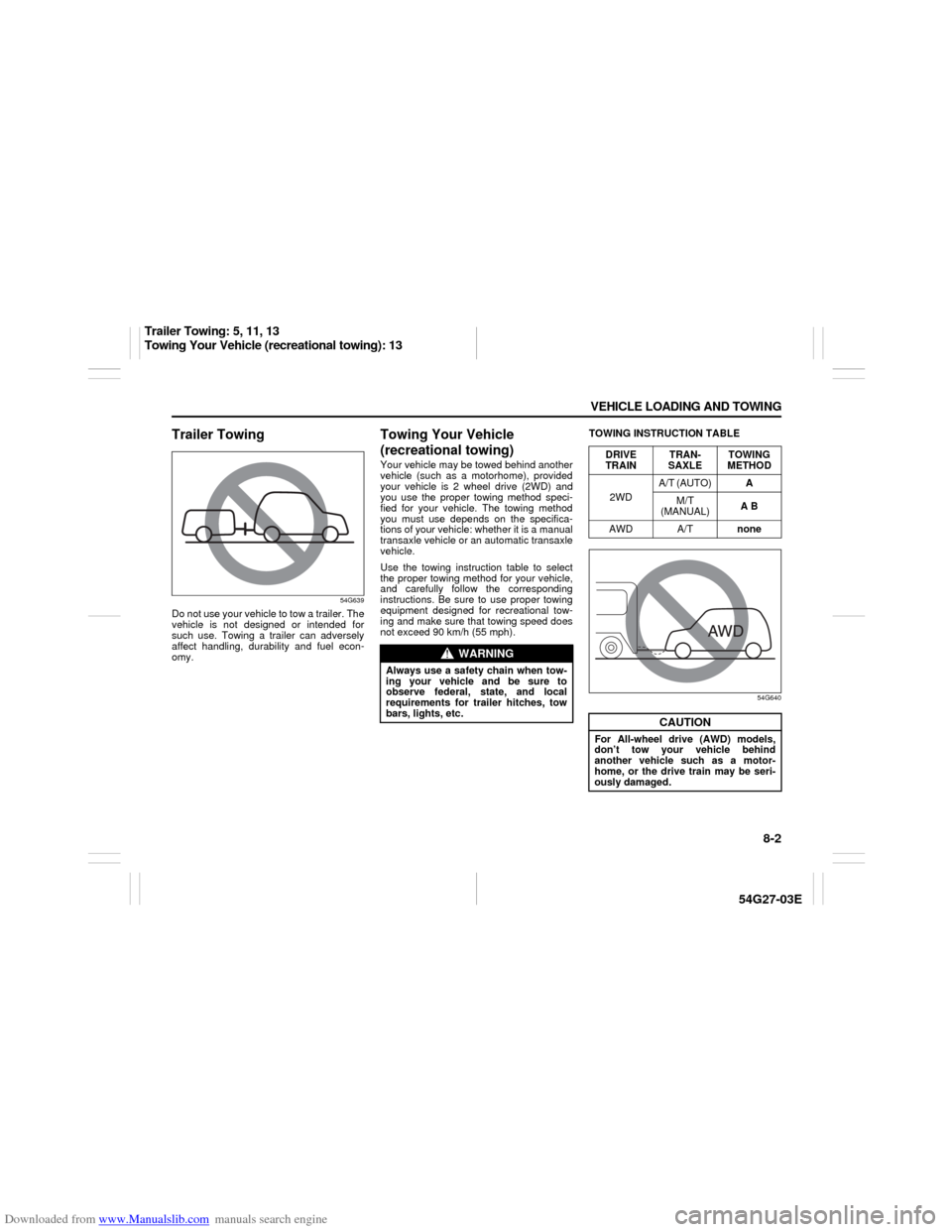2007 SUZUKI AERIO trailer
[x] Cancel search: trailerPage 147 of 232

Downloaded from www.Manualslib.com manuals search engine VEHICLE LOADING AND TOWING
8
54G27-03E
54G215
VEHICLE LOADING AND TOWINGVehicle Loading ................................................................... 8-1
Trailer Towing ...................................................................... 8-2
Towing Your Vehicle (recreational towing) ...................... 8-2
Page 149 of 232

Downloaded from www.Manualslib.com manuals search engine 8-2 VEHICLE LOADING AND TOWING
54G27-03E
Trailer Towing
54G639
Do not use your vehicle to tow a trailer. The
vehicle is not designed or intended for
such use. Towing a trailer can adversely
affect handling, durability and fuel econ-
omy.
Towing Your Vehicle
(recreational towing)Your vehicle may be towed behind another
vehicle (such as a motorhome), provided
your vehicle is 2 wheel drive (2WD) and
you use the proper towing method speci-
fied for your vehicle. The towing method
you must use depends on the specifica-
tions of your vehicle: whether it is a manual
transaxle vehicle or an automatic transaxle
vehicle.
Use the towing instruction table to select
the proper towing method for your vehicle,
and carefully follow the corresponding
instructions. Be sure to use proper towing
equipment designed for recreational tow-
ing and make sure that towing speed does
not exceed 90 km/h (55 mph).TOWING INSTRUCTION TABLE
54G640
WARNING
Always use a safety chain when tow-
ing your vehicle and be sure to
observe federal, state, and local
requirements for trailer hitches, tow
bars, lights, etc.
DRIVE
TRAINTRAN-
SAXLETOWING
METHOD
2WDA/T (AUTO)A
M/T
(MANUAL)A B
AWD A/Tnone
CAUTION
For All-wheel drive (AWD) models,
don’t tow your vehicle behind
another vehicle such as a motor-
home, or the drive train may be seri-
ously damaged.
Trailer Towing: 5, 11, 13
Towing Your Vehicle (recreational towing): 13
Page 186 of 232

Downloaded from www.Manualslib.com manuals search engine 9-33 INSPECTION AND MAINTENANCE
54G27-03E
Label. The cargo load capacity can be
determined as described below.
Cargo Load Capacity – Maximum weight
of cargo and luggage that the vehicle can
safely carry. Cargo load capacity is the dif-
ference between the total load capacity of
the vehicle and the total combined weight
of all vehicle occupants. Refer to “Steps for
Determining Correct Load Limit” for details
on how to determine cargo load capacity.
GVWR – Maximum permissible overall
weight of the fully loaded vehicle (including
all the occupants, accessories and cargo
plus the trailer tongue weight if towing a
trailer).
GAWR – (Front and Rear) Maximum per-
missible weight on an individual axle.
Seating Capacity – Maximum number of
occupants the vehicle is designed to carry.
NOTE:
Even though the number of occupants is
within the seating capacity, you still must
make sure that you do not exceed the total
load capacity of the vehicle.
Total Load Capacity – Maximum permissi-
ble weight a vehicle can carry including the
weight of all the occupants, accessories,
cargo, plus trailer tongue weight (if towing
a trailer).
The weight of any accessories already
installed on your vehicle at the time of pur-chase, or that you or the dealer install after
purchase, must be subtracted from the
total load capacity to determine how much
capacity remains available for occupants,
cargo, and trailer tongue weight (if towing
a trailer). Contact your dealer for further
information.
Actual weight of the loaded vehicle and
actual loads at the front and rear axles can
only be determined by weighing the vehi-
cle using a vehicle scale. To measure the
weight and load, try making your vehicle to
a highway weighing station, shipping com-
pany or inspection station for trucks, etc.
Compare these weights to the GVWR and
GAWR (front and rear) listed on the Safety
Certification Label. If the gross vehicle
weight or the load on either axle exceeds
these ratings, you must remove enough
weight to bring the load down to the rated
capacity.
WARNING
Never overload your vehicle. Over-
loading your vehicle can cause dam-
age to your tires and lead to poor
steering and braking which can result
in an accident. The gross vehicle
weight (sum of the weights of the
loaded vehicle, driver and passen-
gers) must never exceed the Gross
Vehicle Weight Rating (GVWR) listed
on the Safety Certification Label. In
addition, never distribute a load so
that the weight on either the front or
rear axle exceeds the Gross Axle
Weight Rating (GAWR) listed on the
Safety Certification Label.
WARNING
Always distribute cargo evenly.
To avoid personal injury or damage
to your vehicle, always secure
cargo to prevent it from shifting if
the vehicle moves suddenly.
Place heavier objects on the floor
and as far forward in the cargo area
as possible. Never pile cargo
higher than the top of the seat-
backs.
Fuses: 7
Page 187 of 232

Downloaded from www.Manualslib.com manuals search engine 9-34 INSPECTION AND MAINTENANCE
54G27-03E
Steps for Determining Correct Load
Limit
1) Locate the statement “The combined
weight of occupants and cargo should
never exceed XXX kg or XXX lbs” on
your vehicle’s placard.
2) Determine the combined weight of the
driver and passengers that will be riding
in your vehicle.
3) Subtract the combined weight of the
driver and passengers from XXX kg or
XXX lbs.
4) The resulting figure equals the avail-
able amount of cargo and luggage load
capacity. For example, if the “XXX”
amount equals 1400 lbs and there will
be five 150 lb passengers in your vehi-
cle, the amount of available cargo and
luggage load capacity is 650 lbs (1400
– 750 (5 x 150) = 650 lbs).
5) Determine the combined weight of lug-
gage and cargo being loaded on the
vehicle. That weight may not safely
exceed the available cargo and lug-
gage load capacity calculated in Step 4.
6) If your vehicle will be towing a trailer,
load from your trailer will be transferred
to your vehicle. Consult this manual to
determine how this reduces the avail-
able cargo and luggage load capacity
of your vehicle.
Vehicle Loading Example
As an example, suppose that the Tire and
Loading Information label on your vehicle
indicates that your vehicle’s total loadcapacity is 950 lbs. If you were to drive
your vehicle with one passenger, and the
total combined weight of you and your pas-
senger was 350 lbs, then the cargo and
luggage capacity of your vehicle would be
600 lbs (950 – 350 = 600 lbs).
If you later added 2 more passengers, hav-
ing a combined weight of 325 lbs, the
cargo and luggage capacity of your vehicle
would be reduced from 600 lbs to 275 lbs
(600 – 325 = 275 lbs). As you can see, as
the number and combined weight of vehi-
cle occupants increase, the vehicle’s cargo
and luggage capacity decreases.
Suppose again, that you were to take a trip
in your vehicle with the same three pas-
sengers described above, and you
decided to tow a trailer having a trailer
tongue weight of 75 lbs. The cargo and
luggage capacity would be reduced again,
to 200 lbs (275 – 75 = 200 lbs).
Determining Compatibility of Tire and
Vehicle Load Limits
The tires on your vehicle, when they are
inflated to the recommended tire inflation
pressure, have a load-carrying capacity
that is greater than the load that will be on
the tires when the vehicle is at its GVWR
or GAWR limit. Never use replacement
tires that have a load-carrying capacity
less than the original tires on your vehicle.
Tire load-carrying capacity information is
molded into the tire sidewall typically
shown as “Max. Load”. Use of replacement
tires with a lower load-carrying capacitythan the original tires, or failure to keep the
tires inflated to recommended tire pres-
sure, may reduce the GVWR or GAWR
limit of your vehicle.
NOTE:
Use of replacement tires with a higher
load-carrying capacity than the original
tires, or using a tire inflation pressure
higher than the recommended tire inflation
pressure, will not increase the GVWR or
GAWR limit of your vehicle.
Headlight Aiming:
Bulb Replacement: 7
Page 230 of 232

Downloaded from www.Manualslib.com manuals search engine 15-4 INDEX
54G27-03E
Rear Window Defroster Switch
..........................................4-10
Rear Window Wiper/Washer Switch
..................................3-5
Refill with Oil and Check for Leaks ....................................9-13
Refilling
................................................................................9-12
Remote Audio Controls
.............................................. 3-8
, 4-43
Replace the Oil Filter
...........................................................9-13
Replacement of the transmitter battery
.............................2-4
Reporting Safety Defects
....................................................12-4
SSafety Certification Label
...................................................12-2
Seat Adjustment
..................................................................2-11
Seat Belt Extender ...............................................................2-30
Seat Belt Hanger
..................................................................2-21
Seat Belt Inspection
............................................................2-22
Seat Belt Pretensioner System
..........................................2-31
Seat Belt Reminder
..............................................................2-19
Seat Belts and Child Restraint Systems
...........................2-13
Selection of Coolant
............................................................9-17
Shoulder Anchor Height Adjuster
......................................2-21
Side Door Locks
..................................................................2-1
Snow Tires
...........................................................................9-31
Spark Plugs ..........................................................................9-21
SPECIFICATIONS
................................................................14-1
Specified Fluid
.....................................................................9-16
Specified Gear Oil ................................................................9-14
Specified Oil
.........................................................................9-11
Speedometer ........................................................................4-7
Spot Light
.............................................................................5-7
Starting the Engine
..............................................................6-2
Steering Wheel
.....................................................................9-24
Stowing Rear Center Lap-Shoulder Belt
...........................2-19Sun Visor
............................................................................. 5-6
Supplemental Restraint System (air bags)
....................... 2-32
TTachometer
.......................................................................... 4-9
Temperature Gauge
............................................................ 4-10
Thermometer
....................................................................... 4-13
Tilt Steering Lock Lever
..................................................... 3-6
Tire Chains
.......................................................................... 7-3
Tire Changing Tools
........................................................... 5-12
Tire Inflation Pressure ........................................................ 9-26
Tire Inspection
.................................................................... 9-27
Tire Rotation
........................................................................ 9-29
Tire Sidewall Labeling
........................................................ 9-25
Tire Size
............................................................................... 9-26
Tires
..................................................................................... 9-25
Towing a Disabled Vehicle
................................................. 10-5
Towing Your Vehicle (recreational towing)
...................... 8-2
Trailer Towing
..................................................................... 8-2
Trip meter
............................................................................ 4-7
Troubleshooting
.................................................................. 4-47
Trunk Lid
.............................................................................. 2-7
Trunk Light .......................................................................... 5-13
Turn Signal Indicators
........................................................ 4-6
Turn Signal Operation ........................................................ 3-4
UUniform Tire Quality Grading
............................................. 9-29
Unlatching and Latching Detachable Connector
............. 2-18
Using the Transaxle
............................................................ 6-4
VVehicle Cleaning
................................................................. 11-3
Vehicle Identification Number
........................................... 12-1